There and back again: A curator’s tale



College of Letters & Science INFOCUS October 2022, Vol. 12, No. 10
Art history professor cocurates Tolkien’s manuscripts for Milwaukee exhibit Pg. 6
Photo by Kathryn Ecsedy,
@dragonbitebooks
Feature Stories


Econ professor explains labor’s momentum
VP Kamala Harris visits UWM
Gov. Tony Evers listens to student concerns
Art history professor co-curates Tolkien exhibit Professor lands Alzheimer’s grant
UWM helps Alpine Valley go green Summer research gives students a leg up Planetarium plans James Webb telescope show
A look at labor: Economics banner year
The labor movement is having a moment.
Columns
Alumni Accomplishments
Laurels and Accolades
People in Print
In the Media Passings
Upcoming Events
Published the first tuesday of each month by the college of letters and science at the university of Wisconsin milWaukee contact us at let-sci@uwm.edu
l&s acting dean: nigel rothfels
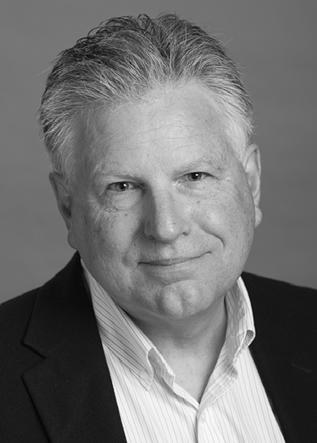
In Focus editor: deanna alba
p.2 p.4 p.5 p.6 p.9 p.10 p.12 p.14 p.13 p.15 p.15 p.16 p.17 p.18
Over the past two years, union workers everywhere from Kellogg’s to John Deere to Kaiser Permanente declared strikes, demanding better working conditions and higher wages. Just last month, railway unions and freight companies narrowly avoided a strike that would have shut down the nation’s major shipping lines.
In addition, union interest has grown across the country. The National Labor Relations Board (NLRB) has reported a 57% increase in petitions to form unions, a significant uptick after decades of waning support for labor. Most notably, Starbucks and Amazon workers have led efforts for unionization despite opposition from their employers.
What’s driving this national moment for organization and collective action? John Heywood, a distinguished professor in UWM’s Department of Economics and the director of the graduate program in human resources and labor relations, has been pondering this question. He says that the United States is at a unique point in history, with three main factors converging to give labor unions a banner year.
The driving forces
• A tight labor market
Unemployment is low, labor force participation has shrunk, and that means that workers have increased power over their circumstances. Labor force participation refers to the share of adults who are working or who are looking for work.
With those factors, businesses are having a hard time finding enough workers to fill the job openings they have, Heywood said.
“For the first time since at least the late ‘70s, you can walk up to a factory and find a well-paying middle class job –without a college education,” he observed.
2 • IN FOCUS • October, 2022 Find us at uWMLetsci Contents
John Heywood
Economics professor explains unions’
• The COVID-19 pandemic
The coronavirus and the labor market’s response to it revealed how unevenly certain industries treat employees.
“The line workers were often working in unsafe conditions trying to keep the business open, while managers and white-collar workers worked from home,” Heywood said. “The ‘essential workers’ kept the place going and faced much greater risk and hardship.”
Heywood says it’s no coincidence that workers in industries like health care, shipping, warehousing, retail, and restaurants are now the ones organizing unions.
• A friendly White House
President Biden and his administration have, for the most part, been supportive of unions, Heywood said.
“He likes to call himself ‘America’s most pro-union president,” he added, noting that Biden has appointed people to the NLRB and interceded on behalf of unions in the past.
Whether Biden has actually earned that moniker is a matter of opinion, but “You’re less likely to face administrative barriers if you’re trying to create a union. I think that helps as well,” Heywood said.
Caveats to the labor movement’s momentum
Heywood warned that voting to unionize is only half the battle.
“The next step is reaching a first contract, which sets the stage for subsequent contracts in the ongoing labor management negotiations,” he said, noting that it can often take a year or more to reach a contract. “(Of the) 225 Starbucks that accomplished Step 1 (voting to unionize), none have reached the next stage.”
Employers frequently throw up road blocks to contracts. While they are supposed to bargain in good faith, Heywood said, it’s difficult to prove if they are not, and the penalties for not doing so are minimal. If an employer fires a union organizer, for example – an illegal retaliatory action– the typical penalty is only that they must rehire that worker.
“Of course, the unions are going to push for better working conditions and higher wages, and that’s costly,” Heywood acknowledged. “But we know lots of employers that have tried to avoid unions by giving (workers) a lot of (their demands) already. So that indicates that … the major part of their opposition is that the loss of control is very costly.”
Heywood thinks that most businesses that want to avoid unions do so because they will lose some of their control over their employees. Unions may give workers more of a say in how the business is organized, how employees may be hired and fired, how workplace safety issues are managed, and more.
“I think it’s fair to say that most American managers view unions as a managerial failure,” Heywood said.

Labor in Wisconsin
Once one of the most progressive states for labor, laws like Act 10 and Right to Work have stripped Wisconsin unions of much of their power. Act 10, passed in 2011, curtails the right of public sector unions to collectively bargain, with the exception of police and fire unions. Right to Work ensures that workers cannot be forced to join a union at their place of employment. That means that a worker will not have to pay dues to support a union, even though they might still reap the benefits of the union’s negotiations with the employer.
That hasn’t stopped for the push for unions in Wisconsin. Colectivo Coffee employees voted to unionize by thinnest of margins last year, and their vote was certified by the NLRB in March. Workers at UW Health have also been seeking to unionize, hoping to gain better working conditions after the pandemic left them overworked and understaffed.
“It’s an ongoing process, trying to find common ground in industry, and making worker’s lives richer, and helping firms investigate progressive participation,” Heywood said. “A union need not be a managerial disaster; there are successful instances of labor/management cooperation. So, being an eternal optimist, I hope that’s where we’re heading.”
By Sarah Vickery, College of Letters & Science
3College of Letters & Science • UW–Milwaukee •
UWM and L&S students receive visits

Students surprised with VP Harris visit
For Javier Retana Jr., the chance to meet and talk to the vice president of the United States was an honor and a chance to represent the Latino community.
Retana, a UWM senior in civil engineering from Kenosha, is a first-generation university student. “My parents came here from small villages in Mexico, so they were excited that I had this opportunity.”
Retana was one of the participants in a roundtable on Hispanic community concerns who visited with Vice President Kamala Harris during her trip to the UWM campus Thursday, Sept. 22.
The students in Gina Vlach’s American Government class were somewhat surprised when the vice president stopped in to talk to them while on campus. However, having their class location moved, getting “wanded” before class and having two Secret Service agents sitting in had them asking questions about a potential distinguished visitor.
Vlach joked about it: “I told them, ‘Do you think I have that kind of pull?’” However, when a “wall of cameras” suddenly appeared at the back of the room, the secret was out.
Vlach is a graduate student in political science who leads the discussion session of the class taught by Kathleen Dolan, distinguished professor of political science. Vlach had been asked to keep the Harris visit secret until it actually happened.
In the roundtable with Hispanic community organizations, Harris discussed and listened to representatives who discussed issues of concern to the community.
Alberto Maldonado, director of UWM’s Roberto Hernández Center, was impressed with the vice president’s demeanor. “She was extremely responsive when I mentioned the work we are doing helping thousands of students from the community who aspire to excel and get ahead and are often the first ones in their family go to college.”
Feeling encouraged
In Vlach’s class, the vice president talked about the climate crisis and the need for the students – most of them freshmen – to lead on environmental causes. Protecting the planet should be a nonpartisan issue, she told them.
That was a message that resonated with Amber Myles, a first-year student in the American Government class who plans to become an environmental lawyer.
“She just solidified what I already knew, the climate crisis will be an even bigger issue for our generation than it is now,” Myles said. “And we must make the right decisions so that we can continue to live here.”
Myles said she was surprised by the class visitor and, though she didn’t have any questions for her, “I did tell her she was beautiful in person.”
She was also inspired by what the vice president represented.
“Meeting her was very important to me. I am the only black female in that class, so I felt encouraged to keep going along this path that I am on. Also being a retired naval veteran and being able to meet someone who is so important to our country right now was very big to me.”
There were cell phone photos aplenty in the brief classroom visit and student Averell Charlton Diesch got the vice president to sign a copy of the Constitution.
Stirring interest in government
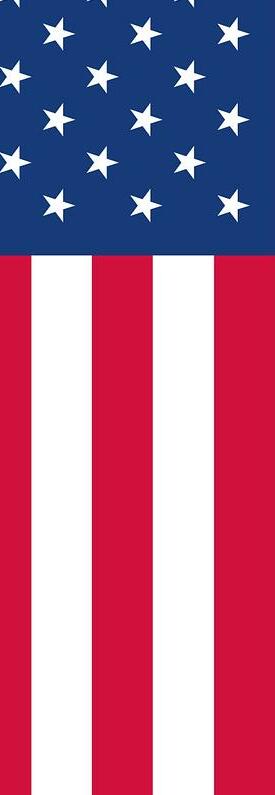
Charlton Diesch is a junior transfer student from the University of Hong Kong, majoring in economics. He’s been considering a political science minor or maybe a second major because he’s interested in public administration.
“This (experience) will probably push me toward pursuing a second major,” he said. “I had her sign Article 1, Section 3, which she thought was a good choice given her actions as president of the Senate have been notable.” (That section of the Constitution refers to the composition and workings of the Senate.)
4 • IN FOCUS • October, 2022
Vice President Kamala Harris shakes hands with a student in a government class during her September visit to UWM. (UWM Photo/Troye Fox)
visits from two distinguished guests
Students discuss the issues with Gov. Evers
Evers met with about 30 students to answer their questions about issues they are most interested in, which included college affordability and access, social equity, climate change and reproductive rights.
Kaitlynn Bonner, a doctoral student in urban education, attended primarily to hear what the governor had to say about protecting reproductive rights in Wisconsin and to join the discussion. She came to a similar conclusion.
Ernesto Parra felt honored when one of his political science professors asked him if he would like to take part in a student roundtable discussion with Wisconsin Gov. Tony Evers, who visited UWM on Tuesday.

“I wasn’t going to turn down an opportunity to meet the governor,” said Parra, a junior studying accounting and finance with a political science minor.
Alex Nelson, a senior majoring in biological sciences, felt the same way.
“To call this experience ‘enriching’ would be an understatement,” Nelson said. “I felt this would be a unique opportunity to connect with policy on a deeper level. I also wanted to hear the potent insights that I knew the other student panelists would bring.”
Evers then toured some of the student-facing offices on campus, including the Roberto Hernandez Center, the Office of Undergraduate Research, Black Student Cultural Center, Student Success Center and the Military and Veterans Resource Center, meeting and chatting with more students.
Many of the participating students said the governor’s answers met their expectations, but they appreciated the fact that he gave a realistic view about what could be accomplished on issues where the political parties disagree.
Parra said that reinforced his belief in the importance of voting.
“It’s always been one of my goals to be able to have an impact on the community,” Parra said. “And that’s why, ever since I turned 18, I’ve been really active in every election cycle. I feel like it’s really important, even if you’re feeling hopeless (about politics). Just being able to exercise that right (voting) is a privilege.”
“Some topics discussed quite simply are not changes he could make alone as governor,” Bonner said. “I think he did well in explaining that. What I took away from this is the most important action we can take is to get out and vote, and help others vote as well.”
For Nelson, the governor’s message that students use their educations to help effect the change they want to see resonated the most.
“The terms ‘outreach and advocacy’ – or ‘get out there,’ as Gov. Evers put it – are two of the most vital measures that we have as welleducated, grassroots organizers,” he said.
At the Office of Undergraduate Research after the event, Nelson had a chance to see Evers again and was impressed with his authentic interest in young problemsolvers. “Despite being on a tight schedule, he took the time to ask each of the seven students in the room detailed questions about their research projects.”
By Laura Otto, University Relations
Like Myles, he appreciated Harris’ message about the environment.
“While the presenter was remarkable, the message itself wasn’t new, he said. “The environment is important and ultimately younger generations bear the responsibility to work to fix it because while we didn’t cause the problems, we have benefited from its exploitation and will have to pay the price if it isn’t done.”
This article has been edited for length. For a full version, visit the UWM Report website.
By Kathy Quirk, University Relations
5College of Letters & Science • UW–Milwaukee •
UWM student Ernesto Parra stands with Wisconsin Gov. Tony Evers. (UWM Photo/ Troye Fox)
Middle to Earth to Marquette: Art
In a room at Marquette there lived The Hobbit manuscript. And the manuscript of The Lord of the Rings. And more than 11,000 pages of drafts, notes, stories, and illustrations of celebrated author J.R.R. Tolkien’s meticulous work.
Marquette University purchased Tolkien’s manuscripts and notes for the institution’s archives in 1957, and has added to the collection in the decades since. Those materials are currently on display at Marquette University’s Haggerty Museum of Art through Dec. 23 as part of the museum’s “J.R.R. Tolkien: The Art of the Manuscript” exhibit.

The exhibit’s co-curator is Sarah Schaefer, an assistant professor of art history at UWM. She was delighted to help bring Tolkien’s collection to the public and sat down to talk about Tolkien’s work, the exhibit, and her own love for The Lord of the Rings.
First question: Are you a Tolkien fan?
Of course. I guess my fandom emerged around the same time I thought about art history as a career, but I never though the two would be married. I knew when I moved to Milwaukee that there was a big Tolkien archive at Marquette, and I half-thought, wouldn’t it be great if someday I could do something with that?
And you did! How did you come to be a co-curator?
Bill Fliss, who’s the archivist of the Tolkien collection at Marquette, does semi-regular public viewings. I signed up for one of those in 2018. He saw that I had a UWM email address and we connected at that viewing.
Left:
J. R. R. Tolkien English, 1892–1973
The Book of Mazarbul, first of three facsimile pages, third version, ca. 1940–41 Ink, colored pencil, and pencil on paper
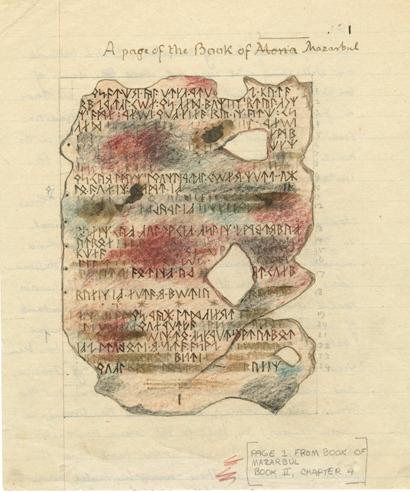
83/8 x 67/8 in. (212 x 174 mm)
Raynor Memorial Libraries, Marquette University
MS. Tolkien, 3/4/12/1a © The Tolkien Estate Limited 2004 www.tolkienestate.com
Left Middle:

J. R. R. Tolkien English, 1892–1973
The Ring Verse, 1940s Ink on paper 8 7/8 x 6 7/8 in. (225 x 175 mm)
Raynor Memorial Libraries, Marquette University
MS. Tolkien, 3/1/3/1a Credit: © The Tolkien Estate Limited 2004 www.tolkienestate.com
All photos courtesy of the Haggerty Museum
Fast forward a couple of years, and I was a meeting with the head curator at the Haggerty – I had curated a show for them a couple of years earlier. It was a meeting about a totally different project, and a date was brought up. The date March 25 was the date (in the books) that the Ring was destroyed, so among Tolkien fans it’s a holiday.
We’re in this meeting and the date March 25 was thrown out. My knee-jerk reaction was, “Fall of Sauron Day!” (One of the people there told me) she was going to a meeting later that day about an exhibition that may be happening on Tolkien at the Haggerty. I was like, I don’t want to push my way into this project, but if there is any way I can be involved, I would love to make that happen.
Had you ever curated a show like this before?
There were three major Tolkien exhibitions in recent years. There was one at the Bodleian (Library at University of Oxford), which is the other main repository of Tolkien’s archives, and then that was repackaged and mounted at the Morgan Library in New York. Then there was one that just recently happened in 2019 at the Bibliothèque nationale in Paris. I had seen the one in Oxford and the one in New York. I already had a good sense of what had been done at these earlier exhibitions.
Bill was concerned we were not going to be able to put on the same kind of show that the Bodleian did, so what could be done to make a solid contribution to the literature and the fandom? I had seen the other shows, so it was easy to develop a concept with Bill.
6 • IN FOCUS • October, 2022
historian
historian co-curates Tolkien exhibit
You settled on the theme, “Art of the Manuscript.” How did you land on that?
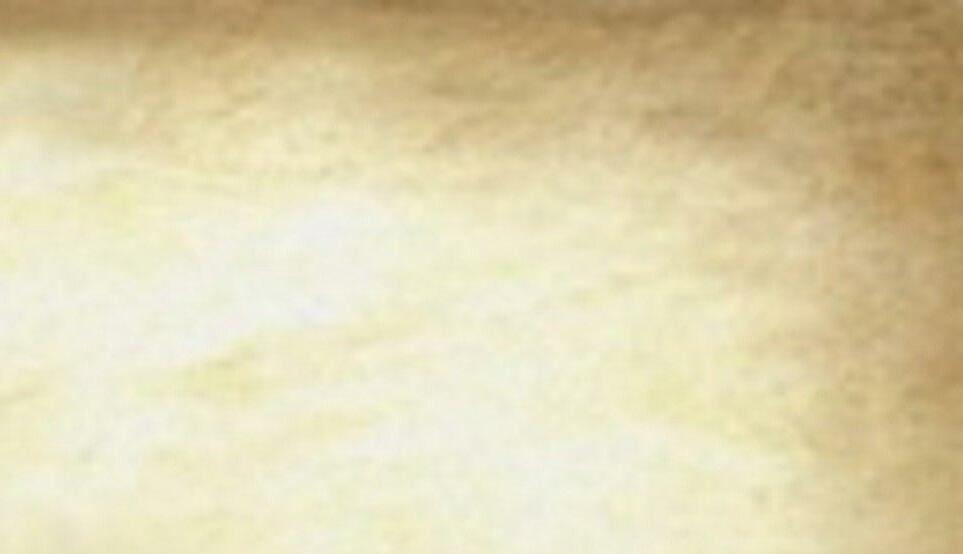
We wanted to create a show that was distinct in some way from the earlier shows. We started thinking: What is the strength of the Marquette collection? And it is the manuscripts – the manuscript pages for The Lord of the Rings, The Hobbit, and then two short stories: Farmer Giles of Ham and Mr. Bliss. There are 11,000 pages of manuscripts, and the whole development of his opus of The Lord of the Rings.
Are there any highlights of the collection that you can tell us about?
There are certain things that we would characterize more as images or artworks in Marquette’s collection, and primary among those for us are these draft pages of the “Book of Mazarbul.” If you remember in the books and in the movie, when they go into the Mines of Moria and find the Tomb of Balin, they find a manuscript there. It’s the dwarf-chronicle that tells of what happened to the dwarves that tried to reinhabit the mines, and it ends with the lines, “Drums, drums in the deep. We cannot get out. They are coming.” That’s how the Fellowship finds out that the orcs had overtaken the dwarves in Moria and they were all dead.
This is such a great object and brings together a lot of the themes of the exhibition. It’s a hand-written manuscript within the story of The Lord of the Rings. Tolkien himself was a scholar of languages and literature and knew so much about medieval manuscripts. He created these pages that are supposed to be facsimile pages of that
What: J.R.R. Tolkien: The Art of the Manuscript
Where: Marquette University Haggerty Museum
When: Now thru Dec. 12
Tickets: $10/person, $8 for seniors and veterans. Visitors must register for a time slot.
More Info: Haggerty Museum website
“Book of Mazarbul.” You can see the writing in the different script forms and the different languages that Tolkien created as well. The finished pages are at the Bodleian and we included them in the show, but all of the draft versions are at Marquette. If you go to the exhibition, all of them are brought together – the draft pages and the finished pages.
How does one curate an exhibition like this? How do you create the experience you want guests to have?
Early on, we identified a number of different audiences we wanted to speak to. Bill and I are both uber-fans, and we wanted to speak to other super-fans, and people who might have gotten to those other exhibitions or had their catalogues. We also wanted to include things that may have been in the other shows that would appeal to the people who hadn’t gotten to see them, or who are maybe more casual fans.
Continued on Page 8
Right Middle: J. R. R. Tolkien English, 1892–1973
Doors of Durin, first drawing, ca. 1940 Ink and pencil on paper 8 7/8 x 6 7/8 in. (225 x 175 mm)
Raynor Memorial Libraries, Marquette University MS. Tolkien, 3/3/10/11b
Credit: © The Tolkien Estate Limited 1989, 2015 www.tolkienestate.com
Right: J. R. R. Tolkien English, 1892–1973
“hringboga heorte gefysed” (“Now was the heart of the coiling beast stirred”), September 1927 Watercolor and ink on paper
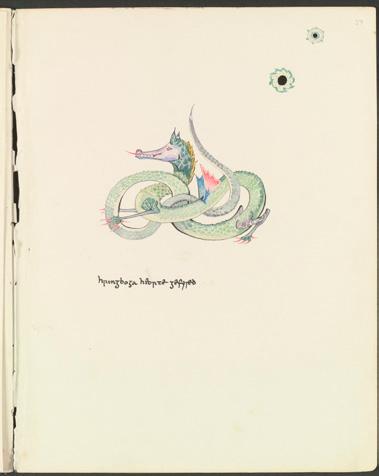
10 15/16 x 8 1/2 in. (278 x 216 mm)
The Bodleian Libraries, University of Oxford MS. Tolkien Drawings 87, fol. 37
Credit: © The Tolkien Trust 1976, 1995 www.tolkienestate.com
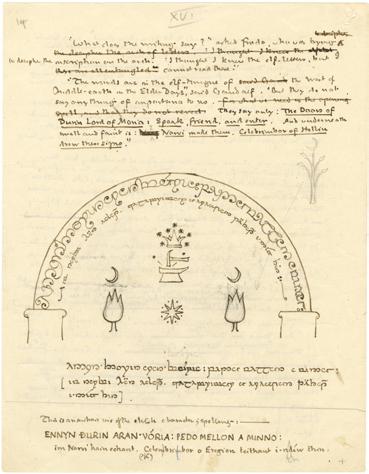
7College of Letters & Science • UW–Milwaukee •
Tolkien exhibit
Continued from Page 7
of heralds, emblems, that he created for different major figures in the broader legendarium. People who were watching the show and come to the exhibition might see those names and draw those conclusions.
Speaking of the show, there has been some controversy surrounding the decision to cast actors of color. Working with Tolkien’s original manuscripts, do you have any thoughts?
First off, and this is the case when doing any kind of analysis for an author who is no longer around, you have to take into account that they cannot respond to these kinds of criticisms.
Sarah Schaefer
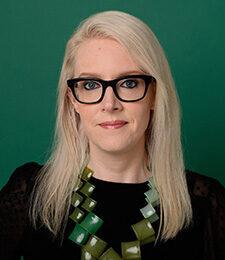
One of the things that I draw people’s attention is a page where we can see what is almost assuredly [Tolkien’s] own tears. When he was writing the chapter, “The Field of Cormallen,” when Frodo and Sam are being praised after the destruction of the Ring, there is a letter that he wrote to his aunt in which he says he “blotted the page with his own tears,” and we have this one manuscript page where you can see the smudge right at that part. And, this is probably the last opportunity in a generation that people will have the opportunity to see the actual real objects, particularly at Marquette. The originals have essentially been retired for 40 years now because these are not very stable pieces of paper. They cannot be exposed to much light and they’re very valuable, obviously. If you’re the type of person who would get a kick out of, and maybe tear up yourself, at seeing his own tears on a piece of paper that he wrote on, this is probably your last chance to do so for quite a while.

Did you ever get chills handling the materials that Tolkien himself handled?
Oh yeah. A big reason that I’m a Tolkien fan is because my dad is a Tolkien fan. He re-read it every other year. Oh really? My dad used to read The Hobbit to my sister and me when we were kids.
It seems like that is so often the case! At the opening, my dad was there and my husband was there. When I was doing my remarks, I cried calling out my dad’s presence because it was so seminal for me getting into Tolkien.
Why now? Was the exhibit meant to coincide with the release of the new Amazon series, or was it just time? It was pretty firmly set as in 2022 from the get-go. The release of the show was pure coincidence. There are some places where I think people will be able to draw connections to what’s in the show. There is an emphasis on The Lord of the Rings, because that’s a big chunk of what is at Marquette, but in the last section … is a series
And, it’s a fantasy world. The idea that it should strictly adhere to some kind of imagined medieval past that isn’t even real is ridiculous. And even in the legendarium, even in places where there are communities or groups – other than the orcs – that seem wholly bad, if you dig deeper into his thinking, there are things that complicate or nuance that. … You can always find answers to combat the rigid ideologies of people who claim that “there are no Black elves.”
I would whole-heartedly agree with the statement that The Lord of the Rings is not racist, and I don’t believe Tolkien was racist. But everyone is a product of their time, and no one is perfect. There are things that I think that any person who reads these books or engages with this material with a critical eye may struggle with a little bit, and I have those same struggles as well. But ultimately, I think the values and ideas that he espoused in these books about friendship and pity and humility are all things we should espouse and try to adhere to.
Did you learn anything new?
So many things! The thing that I always come back to, being a fan and having read enough of the additional material around The Lord of the Rings, is knowing how much time he spent on the secondary world. I have a deep appreciation for that. But having gone through some of the archives, it was even more mind-blowing to me, the stuff that he was able to achieve, the number of realms he committed himself to, the level of precision and excellence that he dedicated to all of these things.
We were going through some of his scholarly papers, and he created these charts of Old English vowel changes across a couple of manuscripts. We saw pages and pages of him developing this, and this is not something he published. This is something he made for his own research, for teaching purposes.
And he still had a social life and was dedicated to his family! He seemed to have a really well-rounded life. That is inspiring to me, that he could maintain his dedication to teaching, to research, to the story that millions and millions of people so deeply love – but also have friendships and a great family life.
By Sarah Vickery, College of Letters & Science
8 • IN FOCUS • October, 2022
Alzheimer’s Association supports research at UWM
Women are at a higher risk than men of developing Alzheimer’s disease. So are people who carry a particular variant of a gene that everyone has, called APOE.
With a $300,000 research grant from the Alzheimer’s Association, a team of scientists, led by psychology and neuroscience distinguished professor Karyn Frick will dive into why women with two variants of the APOE gene are more protected from Alzheimer’s when they take estrogen therapy, while those with a third variant aren’t.
Almost two in three Americans with Alzheimer’s are women, according to the Alzheimer’s Association 2022 Alzheimer’s Disease Facts and Figures. The hormone estrogen protects the brain cells that create and store memories, but estrogen levels decline during menopause, leaving women’s brains more vulnerable to the disease.
Estrogen therapy reduces the odds for some women. Previous research has shown that one of the APOE gene’s three variants, dubbed E4, shows resistance to estrogen’s brain benefits. The other variants, E2 and E3, are not resistant to estrogen therapy.
The researchers’ aim is to find the most effective estrogen compound for each APOE variant to move into human clinical trials.
“We are excited to support this very important work being done by Dr. Frick and her colleagues,” said David Grams, executive director of the Alzheimer’s Association Wisconsin Chapter. “We are committed to investing in promising and innovative research and we’re proud that Wisconsin is home to scientists who are dedicated
Karyn Frick, a distinguished professor of psychology at UWM, and David Grams, executive director of the Alzheimer’s Association Wisconsin Chapter, hold a giant check reflecting the amount of a research grant.
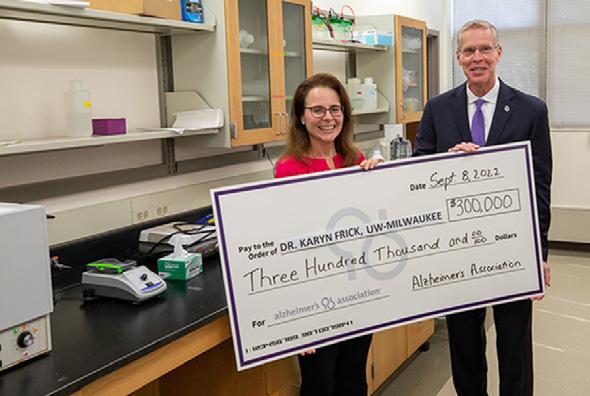
(UWM Photo Services/ Troye Fox)
to helping us find a cure for this devastating disease.”
“All people carry two APOE variants in different combinations,” Frick said, “So risk would be different depending on whether a woman carries the E3/3, E3/4 or E4/4 variants.”
Using an Alzheimer’s mouse model developed by another team member, Mary Jo LaDu of the University of Illinois at Chicago, the researchers will compare oral treatment of a potent estrogen called estradiol along with two novel estrogen compounds on mice that have the APOE variants E3/4 and E4/4.
These treatments target another part needed to solve the Alzheimer’s puzzle in women – estrogen receptors. In order to influence cell function estrogens must enter the cells and bind to these receptors.
APOE is a gene that’s responsible for transporting cholesterol and other types of fats – or lipids – to cells where they can be used or disposed of. Exactly how it’s involved in women’s risk of Alzheimer’s is not fully understood, but the Frick team is working on a hypothesis.
“We think the reason is that E4 doesn’t do as good a job of clearing
lipids and carrying them into cells as E3 and E2 do,” Frick said.
That’s important because both the hormone estrogen and amyloid, a toxic protein that builds up in the Alzheimer’s brain, are lipids, she said.
Many women are reluctant to take hormone therapy, whether it be for memory protection or to ease bothersome menopausal symptoms, because estrogen therapy can increase the risk of breast or uterine cancer and cardiovascular disease for some people. With colleagues from Concordia University Wisconsin and Marquette University, Frick formed the startup Estrigenix Therapeutics, Inc., with the goal of developing drug compounds that provide the benefits of estrogens without harmful side effects.
Her research team will be testing one of Estrigenix’s compounds with this funding, which may provide a new avenue for developing treatments that reduce Alzheimer’s risk in women of multiple APOE variants.
The Alzheimer’s Association is the largest nonprofit funder of Alzheimer’s research in the world, investing over $310 million in more than 950 projects in 48 countries.
By University Relations
9College of Letters & Science • UW–Milwaukee •
Staff & studens spend a summer of sustainability
Alum-turned-instructor leads zero-waste efforts
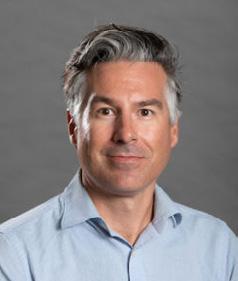
Alpine Valley Music Theatre is one of Wisconsin’s largest music venues. With seating for over 37,000 guests and a 2022 lineup that included acts like Slipknot, Dave Matthews Band, and Phish, the famed venue welcomed hundreds of thousands of music fans over the summer.

And those thousands of fans generated thousands of pounds of garbage.
Enter Quintin Bendixen. Bendixen is the sustainability coordinator at Alpine Valley. He’s also a two-time UWM alum, earning his Bachelor’s degree and Master’s degree in Geosciences, who now teaches sustainability and geosciences classes at both UWM’s Milwaukee and Waukesha campuses. That gives him access to an army of students who signed on as sustainability interns this summer to help Bendixen and Alpine Valley work toward the venue’s goal of zero waste.
“We did pretty good,” Bendixen said of his interns. “We got to 70% waste reduction over the year, which is pretty great.”
Building his position
The sustainability coordinator position is a relatively new one. Alpine Valley Music Theatre is run by the company Live Nation, which operates about 100 music venues across the country. Live Nation has adopted numerous sustainability goals for its venues. Bendixen said those models were helpful when he started the job in spring.
To achieve that, Alpine Valley Music Theatre needs to recycle as much of its waste as possible. And to do that, Bendixen needed to make sure the recycling was sorted. If a recycling is “contaminated” with too many non-recyclable materials, Bendixen explained, recycling centers will throw everything out.
Quintin Bendixen
“I think we as a society overestimate how recycling works,” he said. “As much as we want it to be, and as much as I hope it would be, what goes into our recycling containers isn’t always necessarily going to be recycled.”
“We look at our water footprint and our energy footprint,” Bendixen said, pointing out Alpine Valley’s rainwater capture system (the bathrooms are all flushed with rain water) and its energy saving initiatives.
“The biggest factor is probably trying to achieve zero waste,” he added, “which is tricky to do. If anyone’s been to a big concert like Summerfest, you know you practically kick up plastic cups as you walk around. We’re trying to achieve goals that lead us as close as possible to zero waste.”
To that end, Bendixen recruited a number of interns drawn from the Milwaukee campus’ Conservation and Environmental Science program and from his geosciences classes at the Waukesha campus. He trained his students on how to sort through the mountains of trash leftover at the end of each concert to make sure that they recovered as much recyclable material as possible.
Continued on Page 13
Alpine Valley Music Theatre in East Troy, Wisconsin, is a storied music venue that welcomes thousands of concertgoers each summer. Photo courtesy of Quintin Bendixen.
10 • IN FOCUS • October, 2022
sustainability at Alpine Valley Music Theatre
CES student tackles the trash for internship
Sean O’Dwyer’s summer job was to listen to concerts, hang out in one of the biggest music venues in Wisconsin, and sort through thousands of pounds of garbage at midnight.
It was a great experience, he said.
O’Dwyer was of one of several students drawn from UWM’s Conservation and Environmental Science program and other UW System schools who interned at Alpine Valley Music Theatre this summer. The concert venue in East Troy, Wisconsin, is focusing more on its sustainability efforts, which include diverting recyclable materials away from landfills.
To do that, O’Dwyer and his cohort pulled on their gloves after each event was finished and went elbow-deep into the hundreds of trash bags that guests generated throughout the night, often working through midnight or later.
“That’s the gist of it,” O’Dwyer laughed. “We try to separate as much recycling from trash as possible. Recycling includes glass, metal, and a variety of different plastics. Pretty much we chill in the back of the venue and sort through any trash that comes our way.”
If it sounds like a gross job, it is – but it’s a rewarding one, said O’Dwyer’s internship supervisor, Quintin Bendixen.
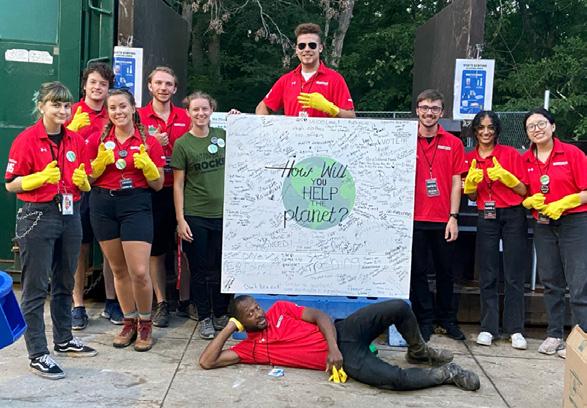
“We actually have fun, believe it or not,” Bendixen said. “I am convinced that without our efforts, 0 percent (of recyclables) would actually end up recycled.”
In addition to sorting the trash, O’Dwyer and his fellow interns also worked to educate Alpine Valley Music Theatre’s guests about sustainable practices. He posted signs about the venue’s environmental efforts and also put up posters that asked concert-goers to generate ideas about sustainable changes they could make in their own lives.
O’Dwyer has long been drawn to the outdoors. He started his schooling at UWM at Waukesha and then transferred to UWM’s main campus. He is majoring in conservation and environmental science in hopes of creating a better world.
“I can tell that there’s a big sense of dread for a lot of the population for the future. I’m doing this a little bit out of a sense of morality,” O’Dwyer said of his education choice. “I feel like it’s probably one of the best things I could do for the world, and at the same time, make a career out of it.”
For that, O’Dwyer knew he needed internship experience. When he found out that Bendixen was recruiting, he signed on immediately.
Alpine Valley Music Theatre sustainability interns pose on the second day of a Dave Matthews Band concert. (Only UWM students are identified.) From left to right: Ingrid Bayer (UWM), Leona Moriarti (UWM), Sean O’Dwyer (UWM), Kristian Zenz (center, UWM), Rachel John (UWM@ WAK) and Katherine Nguyen (UWM@WAK). Not pictured are Briana Laska (UWM@WAK) and Georgia Meysembourg (UWM). Photo courtesy of Sean O’Dwyer.
Bendixen is a senior lecturer at in UWM’s College of General Studies and O’Dwyer has taken many of his classes. In fact, O’Dwyer credits Bendixen with sparking his interest in environmental science.
Bendixen hopes that all of his students gained new experiences and understanding during their internship.
“I think it’s important to get your hands dirty. You can understand individually how each part of the system works and you have a better chance of coming to a conclusion that is holistic and systematic to make it run better,” Bendixen said. “So I hope that they get that ‘boots on the ground’ – or ‘gloves in the bag’ – experience.”
For O’Dwyer, not only did he gain an understanding of systemic sustainability practices, but he also got to listen to great music with some amazing coworkers.
“The best part was being able to go out and experience the concert, and just hanging out with the whole sustainability crew. We’re all really friendly, really nice,” O’Dwyer said. “We’re brothers in arms.”
They’re exactly the people you want to sort trash with you at midnight.
By Sarah Vickery, College of Letters & Science
11College of Letters & Science • UW–Milwaukee •
Summer research gives incoming students a head
Andrew Vail and Noah Kulas got immersed in research – literally – at the School of Freshwater Sciences.
Mariana Colorado worked with live animals for the first time in a lab. Hidayah Osman worked in the community and got to know Milwaukee neighborhoods and people better.
All were part of this summer’s UR@ UWM program, which offered four weeks of on-campus research opportunities to incoming first-year students.
The program, which is part of the Office of Undergraduate Research at UWM, started in 2009. This year 27 students joined campus mentors to learn more about research at a topranked research university.
‘An incredible opportunity’
Some weren’t set on majors yet, others got a chance to explore an area they’re interested in, and others worked in an area outside their planned major to get research experience.
Colorado worked with James Moyer, associate dean and associate professor of psychology, on research looking at the neurobiology of learning, memory and age-related deficit. “A lot of people don’t start research until later in college because they didn’t know these opportunities exist,” she said.
Vail, a graduate of Ronald Reagan High School, and Kulas, a graduate of Waukesha South High School, worked with Carmen Aguilar-Diaz, associate scientist, and Russell Cuhel, senior scientist, at the School of Freshwater Sciences, doing lake and harbor research.
Vail heard about the program at undergraduate orientation and
Elizabeth Lappano (seated, left) and Alesa Buckley (right) join Nathaniel Stern (standing at left), professor of art and mechanical engineering, in his studio as part of their UR@UWM experience. Recent UWM graduate Mich Dillon also joined them in the lab that day. (UWM Photo/Elora Hennessey)
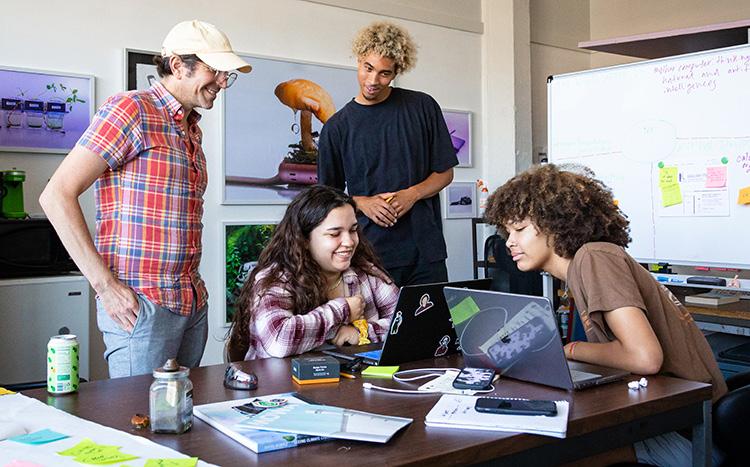
applied right away. “I’m committed to the metropolitan area and getting involved in the community. At the same time UWM is a top-tier research university so this gives students a chance to work with faculty.”
Getting to know faculty
That chance to get to know faculty and staff was a benefit many of the students mentioned. Some said that before their summer experience, they might have been terrified of talking to a professor but found their mentors helpful and approachable.
“He was very open to answering questions and looking at results,” Colorado said of Moyer, her mentor.
“I liked the opportunity to work out in the community,” said Osman, a graduate of Bradley Tech High School. She worked with Arijit Sen, associate professor of architecture, on a research project, Buildings-Landscapes-Cultures Field School. She became involved in Sen’s field school, studying the culture and landscapes of urban garden in a neighborhood. “I liked meeting the people and sharing their positive image of their
neighborhoods. I even went back for some events.”
Students found unexpected connections. “I learned there was more to AI (artificial intelligence) than just computers,” said Elizabeth Lappano, a graduate of Alan B. Shepard High School in suburban Chicago who worked with Nathaniel Stern of art & design and mechanical engineering. His studio does research at the intersection of art, science and technology.
‘Really glad I decided to do this’
Avery Leis from Westby High School and Jagger Vicente from Neenah High School worked with Todd Miller of the School of Public Health on his work involving the Panther Buoys, which are floating in Lake Michigan and are designed to help measure indicators of lake water health.
“I liked the combination of public health and working with water quality and computer science, said Vicente. “I was really glad I decided to do this.”
12 • IN FOCUS • October, 2022
start on college
The incoming first-year students also developed friendships and found their way around. Leis, who comes from a rural area, said the summer program was a great way to get to know the campus.
“It was a good combination of academics and having fun,” he said. “I highly suggest it as a way of getting to know the campus.”
“It’s a really good way to segue into research and get to know people,” said Margrete Henderson, who graduated from Cedarburg High School. She and Maria Jansen of Random Lake High School worked with Chris Lawson, associate professor of educational psychology, on a project looking at cognitive development in children — how different modes of science impact our willingness to accept expert testimony.
The next generation
The UR@UWM program is attracting relatives of some of its earlier students.
“I heard about it through my sister,” said Weston Ingham, a Grafton High School graduate who plans to major in chemistry. “She was part of this program and graduated from UWM and highly recommended it.” Ingham and Joseph Parlier, a Dominican High School graduate, worked with Ionel Popa, associate professor of physics, studying protein molecules.
In addition to the scholarly activities, the program provided fun, friendships and opportunities for students to get to know each other.
Said Kulas at the the poster presentation session that closed the program, “When I came here, I had no idea who these people were and in under a month, they were like family to me.”
By Kathy Quirk, University Relations
Alpine Valley
A culture of sustainability
Continued from Page 10
Live Nation’s push for sustainability is both good for the planet and good for its business. Going green is a trendy practice these days, and Bendixen noted that studies show that music fans tend to be more environmentallyconscious than others in the population.
In addition, more artists are including “green riders,” or environmentallyminded stipulations that a venue must meet for an artist to perform there. Some riders include directives for locally-sourced food or for recycling and sorting procedures.
“(Being green) is an expectation in the industry now,” Bendixen said. “If we do it right, it lowers our costs. So it’s beneficial to us and it’s beneficial to the planet.”
By Sarah Vickery, College of Letters & Science
Alumni Accomplishments

Michael Halvorsen (‘02, BA Journalism, Advertising, and Media Studies) was hired on as the new Vice President of Client Experience at H&R Block. He will be responsible for the company’s customer experience function. Halvorsen previously worked as the Vice President of User Experience and Digital Operations at Kohl’s.
Several Letters & Science alumni were recognized as “Rising Stars in Law” by BizTimes Milwaukee, including Alex Eichhorn (‘11, BA Political Science and Psychology) and Jacob Sosnay (‘03, BA Political Science). Eichhorn is a partner at Tabak Law LLC in the firm’s worker compensation division, advocating for people who are ill or injured due to their employment. Sosnay is an associate attorney at Missner Tierney Fisher & Nichols S.C. and has mentored many other young lawyers coming up through the firm.
Rebekah Bain (‘21, MA History and MLIS) joined Bethel University in Minnesota as the institution’s new archivist/research librarian. She will be responsible for preserving historic materials, processing donations, and assisting researchers.
Annik (Lott) Dupaty (‘95, BA; ‘97, MA Art History) will lead a panel discussion titled, “Distruption: Beyond Initiatives and Toward Purposeful Inclusion in the Arts” at the Wisconsin Leadership Summit in October. Dupaty is the Director of Events and Volunteers at the Madison Museum of Contemporary Art.
Alexander van Abel (‘15, BA; ‘16, MS Mathematical Sciences) joined Wesleyan University as a teaching fellow in statistics. His research focuses on model theory, a branch of mathematical logic.
Nyesha Stone (‘18, BA Journalism, Advertising, and Media Studies) is the founder of Carvd N Stone, a news outlet that both publishes positive local news and distributes annual scholarships. Her company was featured on WUWM Radio
13College of Letters & Science • UW–Milwaukee •
New era of discovery begins with James Webb telescope
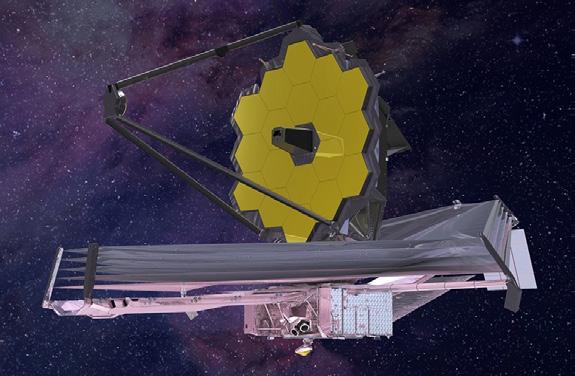
The world is buzzing about the James Webb Space Telescope. Launched on Dec. 25, 2021, Webb takes us into the next phase of space discovery much like the Hubble Space Telescope became a game-changer in the 1990s.
After several months of calibration, the first images began releasing in July 2022. Crisp new images show detail in ways that will expand our understanding of the universe and change how we view other worlds beyond our solar system.
Exoplanets, or planets that orbit stars other than our own Sun, will become easier to locate with the Webb Telescope’s imagery To date, over 5,000 exoplanets have been identified. Not only is the Webb Telescope expected to expand that number, but it will also increase our chances of locating a planet that has Earth-like conditions
An artist’s rendering of NASA’s James Webb telescope. Image courtesy of the UWM and is hospitable to life. In addition, it will enhance our Planetarium. understanding of planetary formation. Children of the 20th
century had their favorite planets in our solar system; kids of the 21st century will have thousands of exoplanets to choose from!
Even more intriguing, Webb will allow us to see deeper into space than ever before. The farther away we can see, the further back in time we can see all the way back to the beginning of the universe.
Why is seeing farther into space equivalent to seeing further back in time? Although light travels incredibly fast, it still takes time to reach us. It takes 8 minutes to reach us from the Sun and approximately 4 years from the next closest star, Alpha Centauri. In other words, the images we see from space represent the past: An image of the Andromeda galaxy, which is a distance of 2 million light years away, actually shows what that galaxy looked like 2 million years ago, not what it looks like at this very moment. Compared to the Hubble Space Telescope, the Webb telescope can see objects that are hundreds of thousands of light years further. We will see early galaxies from when the universe was 13.6 billion years younger than it is now, or 1% of its current age. Webb will hopefully allow us to see the very first stars that ever formed after the Big Bang, and it will help us answer some of our big existential questions, such as, are we alone in the universe? How did the universe come to be?
Hubble (left) and Webb (right) portion of image of the galaxy cluster SMACS 0723.
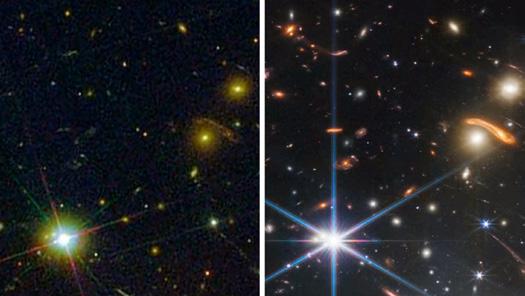
The community is excited about the possibilities of this new space era. UWM Planetarium director Jean Creighton has brought the excitement of the James Webb Space Telescope to the community with talks at Discovery World, the Rotary Club, the Milwaukee Public Library and more. In addition, the Planetarium is hosting public events this fall to highlight the significance of Webb. The “Exploring Exoplanets with the James Webb Space Telescope” planetarium show runs on Oct. 7 and 14; Nov. 4, and 11; and Dec. 2 and 9 at 7 p.m. Shows also include indoor stargazing of the night sky free of light pollution. Tickets are available now.

14 • IN FOCUS • October, 2022
Dr. Jean Creighton, UWM Planetarium Director, gives a talk at Discovery World in November 2021.
New faculty
Victoria McCoy Assistant professor, Geosciences
PhD 2015, Yale University
Previously a Visiting Assistant Professor at UWM
Research focus: I do research in many different areas of paleontology, but currently I am focusing on chemical preservation in fossil plants.
Research discoveries: I discovered that the enigmatic fossil animal called the Tully Monster was actually just a very strange fish.
Current projects: I am investigating the source of fluorescence in fossil plants, to see if it represents original biological fluorescence or if it was produced during the fossilization process. I am also analyzing various wellpreserved fossil plants for evidence of preserved pigments and structural color. Finally, I am studying the fossil record of latex in plants and latexsabotaging behavior in insects.
Fun Fact: I enjoy making quilts in my spare time!
Laurels and Accolades

Charles Paradis (Geosciences) was awarded $350K from the National Science Foundation for a collaborative research project focused on the enhanced biogeochemical flushing of uranium in groundwater. This award is in collaboration with Erica Majumder (UW-Madison) for a total of $500K over the next three years.
Chia Vang (History) was among 27 U.S. historians recently appointed to the Organization of American Historians Distinguished Lectureship Program. The organization provides a list of historians available to deliver keynote speeches, conferences, public and private lectures, seminars, workshops, and other community events.
Anastasios Tsonis (emeritus Mathematical Sciences) was named the recipient of the American Geophysical Union’s (AGU) 2022 Nonlinear Geophysics Section, Ed Lorenz Lecture award, which is bestowed upon individuals for meritorious work or service toward the advancement and promotion of discovery and solution science.
People in Print
Christian M. Gagnon, Hannes Svardal, Anna J. Jasinska, Jennifer Danzy Cramer, Nelson B. Freimer, J. Paul Grobler, Trudy R. Turner (Anthropology) and Christopher A. Schmitt. 2022. Evidence of selection in the upcoupling protein 1 gene region suggests local adaptation to solar irradiance in savannah monkeys (Chlorocebus spp.). Proceedings of the Royal Society B, 289(1982).
James E. Loudon, Alycia E. Lewis, Trudy R. Turner (Anthropology), Michaela E. Howells, Alysha Lieurance and Jack E. Pender. 2022. Heavy metal ecotoxicology of vervet monkeys (Chlorocebus pygerythrus) across field sites in South Africa. Primates, 63: 525-533.
Connie J. Mulligan, Doug M. Boyer, Trudy R. Turner (Anthropology), Eric Delson, William R. Leonard. 2022. Data sharing in biological anthropology. Yearbook of Biological Anthropology, 178(S74): 26-53.

John S. Heywood (Economics), Mehrzad Baktash, and Uwe Jirjahn. 2022. Worker Stress and Performance Pay: German Survey Evidence. Journal of Economic Behavior and Organization, 201: 276 - 291.
Nataliya Palatnik (Philosophy). 2022. Kantian freedom at a distance. British Journal for the History of Philosophy. Online.
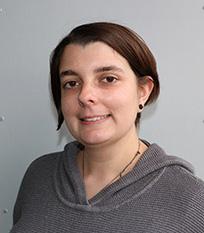
Dexuan Xie (Mathematical Sciences). 2022. An efficient finite element iterative method for solving a nonuniform size modified Poisson-Boltzmann ion channel model. Journal of Computational Physics, 470(15).
Zengwang Xu (Geography) and Bin Jiang. 2022. Effects of Social Vulnerability and Spatial Accessibility on COVID-19 Vaccination Coverage: A Census-Tract Level Study in Milwaukee County, USA. International Journal of Environmental Research and Public Health, 19(19).
15College of Letters & Science • UW–Milwaukee •
In the Media and Around the Community
When Mikhail Gorbachev passed away in August, Jeffrey Sommers (African and African Diaspora Studies and Global Studies) spoke about the former Soviet leader’s legacy on WXRW Radio and penned an article about Gorbachev for Counterpunch. He also wrote about the death of Latvian poet Peteris Cedrins in Counterpunch. Sommers also gave a feature interview on Lithuanian National Radio and Television, titled, “Why inflation is the highest in the Baltic countries - the pandemic benefits are not at all to blame,” on Aug. 21.
Hong Min Park (Political Science) explained how a numbered-seat voting system tends to lead to “winnertake-all” outcomes in a Milwaukee Journal Sentinel article exploring proposed changes to Menomonee Falls School Board elections.
Robert Jeske (emeritus Anthropology) presented “The Myth of Unspoiled Wilderness” at the Door County Master Gardeners Association in September. The talk focused on humanity’s role in the structure of the environment and landscape and the prehistoric development of horticulture.
Jeff Enders, it’s ancient beer. Shepherd Express and the Milwaukee Journal Sentinel detailed how the pair are reaching back to ancient roots for inspiration in their homebrewing. She also spoke on Wisconsin Public Radio about the practice of re-making ancient beers.
Several alumni from Mark Dietz’s (Chemistry & Biochemistry) lab have taken jobs producing radioisotopes essential for medical imaging. BizTimes Milwaukee and Health Imaging ran stories on how his students are helping to reduce U.S. dependence on foreign manufacturers for these materials.
John Reuter (Political Science) will present on “Russia and the U.S.” on Oct. 11 as part of Sheboygan’s Mead Public Library lecture series “Great Decisions.” The lecture will cover America’s approach to arms control, Ukraine, Russian election interference, and opposition politics in Russia.
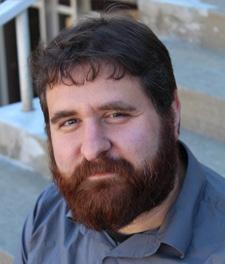
A new Thirty Meter Telescope slated to be built in Hawaii is the subject of indigenous protests. Native Hawaiians are opposed to the project because the instrument would be built on the sacred site of Mauna Kea. Graduate student Melissa Gavin (History) published an article about the situation on History News Network.
Wisconsin Public Radio re-aired an interview with Jocelyn Szczepaniak-Gillece (Film Studies) discussing classic movies. The original interview aired last year.
Emily Latch (Biological Sciences) delivered an invited lecture at the International Deer Biology Congress in Osijek, Croatia, in September. She spoke on her research of using gencomics to advance the conservation of deer species.

The Milwaukee Journal Sentinel detailed the Film Studies program’s plans to host Milwaukee’s first “Home Movie Day” where residents can bring worn out VHS tapes to the university to have UWM volunteers work on refurbishing those homemade movies.

After the announcement that former Green Bay Packers quarterback Brett Favre is the subject of an FBI investigation into the misuse of welfare funds, Michael Mirer (Journalism, Advertising, and Media Studies) explained what the scandal might mean for Favre’s legacy on TMJ4 News. He also spoke to TMJ4 about America’s fascination with the Royal Family following Queen Elizabeth’s death.
Paru Shah (Political Science) spoke to PBS Wisconsin about the recent history of Black voter turnout in Milwaukee and Wisconsin.
In September, NASA intentionally crashed a spacecraft into an asteroid in hopes of knocking it off course. Jean Creighton (Planetarium) explained the purpose of NASA’s test on TMJ4 News. The Wisconsin Muslim Journal also highlighted Creighton’s role in a September Planetarium show focusing on Islam and astronomy.
16 • IN FOCUS • October, 2022
What’s on tap? For Bettina Arnold (Anthropology) and her one-time student
Offering Hope at Milwaukee’s Alzheimer’s Walk

UWM distinguished professor of psychology Karyn Frick received a sizeable grant from the Alzheimer’s Association (see Page 9) to support her research into therapies to treat this disease. To share her research with the community, Frick’s graduate students, including Miranda Schwabe and Aaron Fleischer (on the right), who have been directly involved in this research, staffed a tent at the 2022 Milwaukee Walk to End Alzheimer’s on Sept. 18.
In the Media, con’t.
Following President Biden’s trip to Milwaukee, John Heywood (Economics) spoke with WUWM Radio about the upswing in labor organizing in the U.S.

During the Great Depression, many of the city’s Black residents were evicted from their homes and forced to live in shantytown “Hoovervilles.” WUWM Radio turned to Amanda Seligman (History) to learn more.
Alexander Arnold (Chemistry & Biochemistry) spoke to Wisconsin Public Radio about drug research and development in his role as head of the drug development company Pantherics, Inc.
Hispanic, Latino, Latinx - what do those terms mean and when should they be used? Joseph Rodriguez (History) explained on WUWM Radio
Christine Wolf (Global and International Studies) will present a poster titled, “Cultivating the Curious Professional, International Internship Site Development and Global Studies at the University of WisconsinMilwaukee,” at the Council of International Educational Exchange (CIEE) conference Nov. 8-10 in Seoul, South Korea. This project is supported by the U.S. Department of Education through a National Resources Centers grant.
Passings
Ellen Langill, emerita professor of history, passed away on Aug. 16 at the age of 77. She began her teaching career with stints at Carroll University and at UW-Waukesha (now UWM at Waukesha), before joining the UWM faculty and serving for 20 years as a professor in the History Department. Ellen retired in 2016 after a long tenure filled with accomplishments both in and outside of the classroom. Langill authored more than 40 books focusing on Wisconsin history and businesses, including books on the history of the Waukesha Public Library and Carroll University.

Langill also enjoyed serving beyond UWM’s walls, and had positions on the Waukesha School Board, a sports coach at University Lake School, Waukesha United Way, and more. She earned several awards for her volunteer work and even helped organize a fundraiser to support a food assistance program that her daughter, Kjersten, worked with in San Diego during the height of the COVID-19 pandemic.
For more information, please see Ellen’s obituary or read a profile the profile of her life published in the Waukesha Freeman.
 Ellen Langill Bruce Precourt
Ellen Langill Bruce Precourt
Bruce Precourt, a former senior lecturer in the Classics Program in the Department of Foreign Languages and Literature, passed away on Aug. 17. Bruce majored in classics and graduated from UWM in 1988 with a Bachelor’s degree. He received his Master’s in Classical Languages and Literatures from the University of Chicago in 1990. He taught Greek and Roman mythology, as well as Egyptian civilization courses. Due to his expertise in Egyptian visual and material culture, he also taught Egyptian archaeology and art in the Department of Art History.
For additional information, please see Bruce’s obituary
17College of Letters & Science • UW–Milwaukee •
Upcoming Events
October 5
Master of Legal Studies Info Session. 3-4 p.m. Lubar N120. Learn about the online Master of Legal Studies program offered through Seton Hall Law School. All majors welcome.
October 7
Math Colloquium: Ehrhart Theory and Partial Permutohedra. 2-3 p.m. EMS E495. Erik Insko, Iowa State University, presents.
October 7 and 14
Exploring Exoplanets with the James Webb Space Telescope. 7-8 p.m. Manfred Olson Planetarium. The James Webb Space Telescope will serve as the premier deep space observatory for the next decade. Masks recommended. Ages 4 and up. Tickets are $6 general/$5 for students.
October 12
The Rise of Right-Wing Comedy. 3:30-5 p.m. Curtin 368. Nick Marx, Colorado State University, speaks on his book examining conservative comedians. Click here for more information.
October 13
Women’s & Gender Studies Lunch & Learn with Margaret Noodin. 11:30 a.m.-12:30 p.m. Curtin 181. Margaret Noodin, UWM, presents: “Ginagadawendamin Nooniyang miinwaa Jaagineyang Akiing: Breastfeeding and Exhaustion as Models for Chaos Theory on Earth.” Attend in person or virtually
Creative Writing Program Visiting Writers Series –Phong Nguyen. 3-4 p.m. in Lubar S231 AND 7 p.m. in Curtin 176. Author Phong Nguyen gives a craft talk and reads from his recent work, “Bronze Drum” at 3 p.m. and gives a talk at 7 p.m. Attend in person or virtually
International Career Bootcamp.4:30-6 p.m. Lubar Entrepreneurship Center. Featuring Jake Gill, CEO of Skritter. Alumni panelists include Anastassia White (UWM College of Nursing); Brendaliz Valdes (Assistant District Attorney for Kenosha County); and Maxine Webb (Leading Educators). Bring an updated copy of your resume and your laptop to participate in activities designed to boost your CV. Register here
October 18
Dangerous Women, Effective Changemakers – Film and Panel Discussion. 6-8 p.m. Mitchell 191. Screen the pilot episode in “The Most Dangerous Woman” documentary series. A Q&A follows with panelists Lauren Feaster (Professional Dimensions), Arvina Martin (Emerge Wisconsin), and Marcelia Nicholson (Milwaukee County Board of Supervisors).
October 20
Adventures in Archaeology: UWM Student Research Experiences Abroad. 4-5 p.m. Mitchell 159. Students from classics, art history, and anthropology share their experiences abroad.
October 21
Transland Under Seige: A Brief History. 2-3 p.m. Via Zoom. Helen Boyd Kramer, Lawrence University, presents on trans identity and history.
WGS Vilas Trust Lecture: Indigenous Art as Revisioning and Unsettling Colonial Enclosure. 3-5 p.m. Greene Hall. Mishuana Goeman, University of Buffalo, presents.
Creative Writing Program Graduate Student-Faculty

Reading. 7-8 p.m. Curtin 175. Students Beck Behnke, Sophie Nunberg, and Katherine Witt, along with faculty member Liam Callanan will read. Attend in person or virtually
October 28 and 29
Constellations of the Zodiac: Scorpius. 7-8 p.m. Manfred Olson Planetarium. Explore the astronomy and mythology of the constellaion Scorpius. Masks recommended. Ages 4 and up. Tickets are $6 general/$5 for students.
October 29 Celtic Studies’ Samhain. 5:30-7:30 p.m. Greene Hall. Join the Center for Celtic Studies for a celebration of the Celtic Otherworld through spooky stories, Celtic treats, live music, and a costume contest. Free and open to the public.
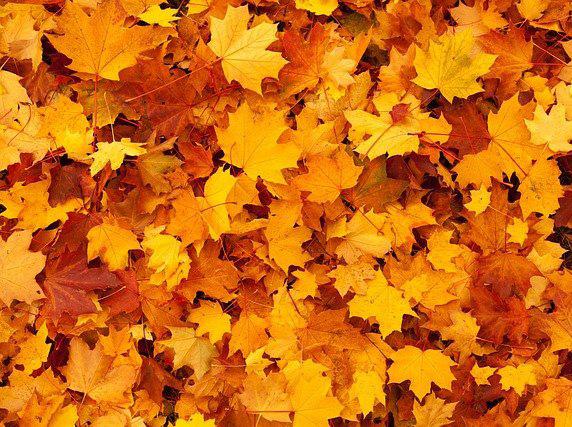
October 2022 Sun Mon Tue Wed Thu Fri Sat 1 2 3 4 5 6 7 8 9 10 11 12 13 14 15 16 17 18 19 20 21 22 23 24 25 26 27 28 29 30 31





































 Ellen Langill Bruce Precourt
Ellen Langill Bruce Precourt










